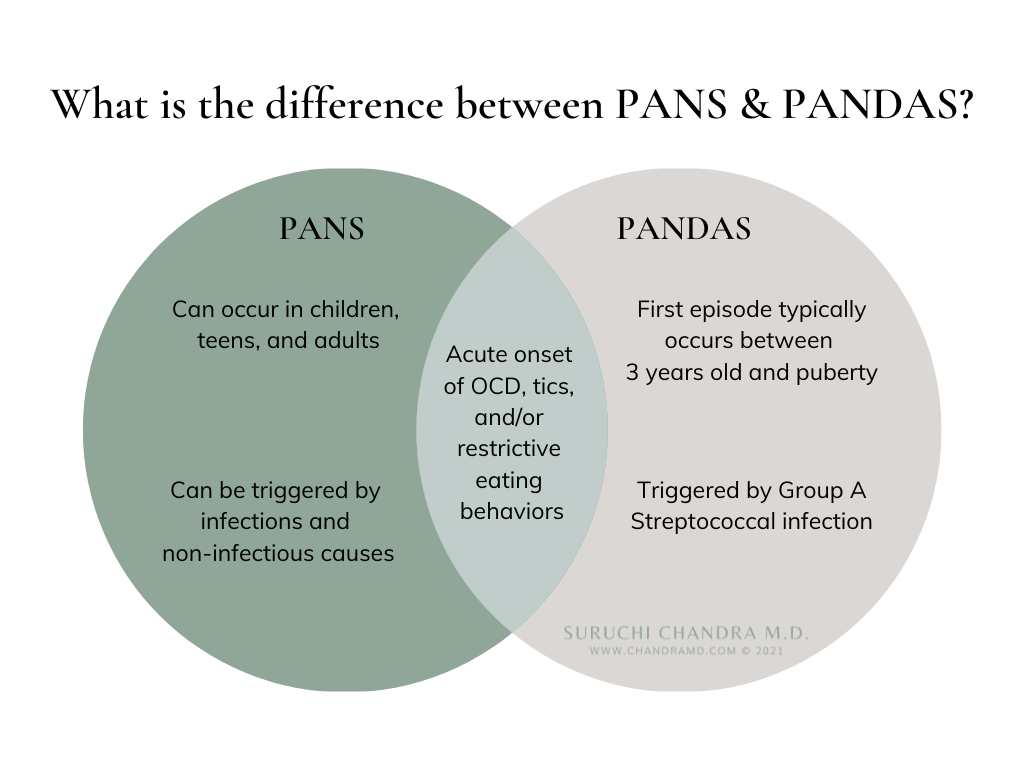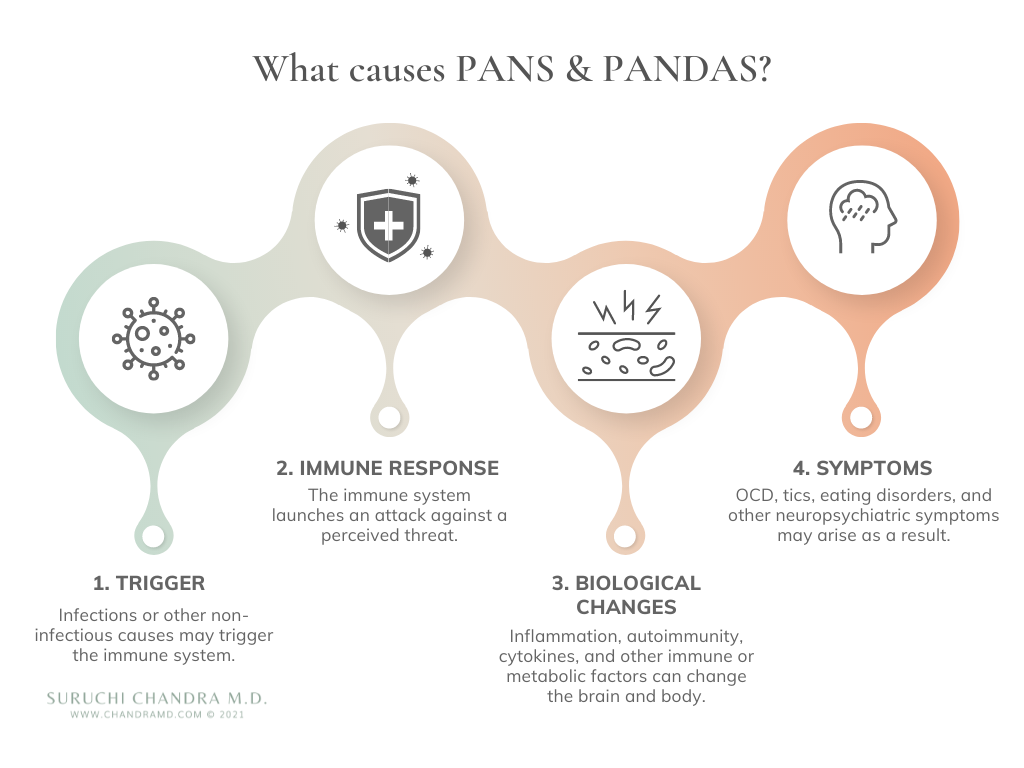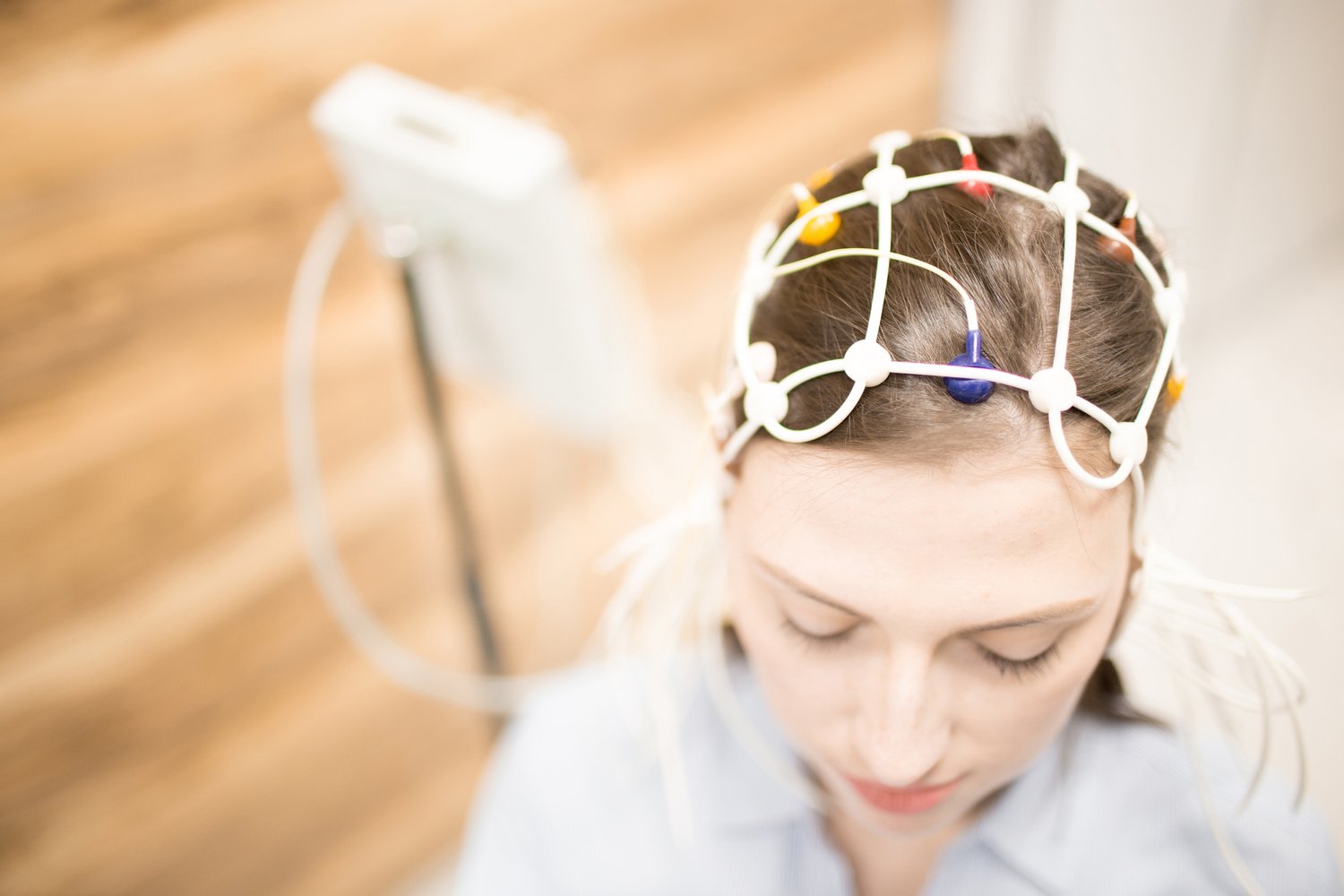If your child has OCD, tics, or an eating disorder, they may have more than a psychological condition. PANS & PANDAS are overlooked medical conditions that can lead to these changes in thinking and behavior. Unfortunately, these neuroimmune conditions are often not recognized, and it can often take years and multiple doctors visits for children to get a proper diagnosis.
As a psychiatrist focused on the intersection of whole-body health and mental health, I have learned that PANS & PANDAS are far more common than we realize. With proper diagnosis, patients can receive treatments that not only help them manage their symptoms, but heal on a biological level.
In this article, we will share the information that can help you recognize these conditions and find resources for support. We address commonly asked questions including:
What is PANS Disease?
PANS (Pediatric Acute-Onset Neuropsychiatric Syndrome) is characterized by the onset of OCD symptoms or disordered eating after an infection or other trigger to the immune system.
The diagnostic guidelines for PANS specify sudden onset of symptoms because children typically experience dramatic changes in their behavior. Some parents may even remember the exact day when they lost their child to this condition.
However, some children with PANS have a more gradual onset of symptoms. One study found that about 8% of children with PANS & PANDAS had a gradual onset. Unfortunately, these children are less likely to get diagnosed because they don’t fit the typical diagnostic picture. Also, the connection between their behavioral changes and a previous infection or trigger may not be as obvious, making a proper diagnosis even more difficult.
What is PANDAS Disease?
PANS is the general term for acute neuropsychiatric disorders in children, while PANDAS (Pediatric Autoimmune Neuropsychiatric Disorder Associated with Streptococcal Infections) is the subset of disorders triggered by Group A strep infections. Children with PANDAS typically have a history of strep throat or positive strep test.
While the initial trigger for PANDAS syndrome is strep, future flare-ups of symptoms can be due to other causes, including viral illnesses, sinusitis, and non-infectious triggers.
Most of the research in the field of pediatric neuroimmune conditions has focused on PANDAS and strep. However, as we learn more about these conditions, it is possible that strep may not be the primary infection triggering psychiatric symptoms in children.

PANS & PANDAS Symptom Checklist
PANS & PANDAS are whole-body conditions, which means that most children often have a variety of psychological and medical symptoms:
CORE SYMPTOMS
The core symptoms of PANS are OCD-like behaviors or restricted eating. Motor tics are also a symptom of PANDAS.
In addition to more well-known OCD behaviors such as handwashing or counting, children may have obsessive thoughts about food. They may change their eating habits because of contamination fears, fears of choking, vomiting, or swallowing, and/or sensory issues. Others may have concerns about body image and weight, which can also lead to restrictive eating and weight loss. In one study, researchers found that 52% of children with pediatric eating disorders also met the criteria for PANS diagnosis.
ASSOCIATED SYMPTOMS
In addition to OCD or new eating restrictions, diagnostic guidelines say that children must also have symptoms from at least two of the following categories:
-
This includes generalized worries or fears, specific phobias, panic attacks and separation anxiety. Children may look like they’re in fight-or-flight mode or terror-stricken.
-
A child who was once happy and easygoing may start throwing tantrums or losing interest in activities and playing.
-
Behaviors can be disruptive at home and school and even lead to safety concerns at times.
-
Children can suddenly start behaving as if they were a younger age, both emotionally and academically. For example, they may become more clingy and insist on being next to a parent at all times.
-
Children may have difficulty focusing on school or completing homework when obsessive thoughts become all-consuming. Others may have problems with memory and cognitive processing.
-
Sensory issues include light, nose, and texture sensitivity.
Motor issues include tics, abnormal motor movements, and deterioration of handwriting (dysgraphia).
-
Sleep problems and urinary disturbances (urinary frequency, urgency and bedwetting) are the most common medical symptoms. Headaches, gastrointestinal symptoms, and joint pain may also be present.
What causes PANS & PANDAS?
Traditionally, we have thought that OCD and eating disorders are caused by emotional stress or chemical imbalances in the brain.
However, research has taught us that infections or an unhealthy immune response may also lead to these behaviors. For example, Lyme disease, mycoplasma infection (ex. pneumonia), and even environmental toxins may result in psychiatric symptoms through different pathways, including:
-
Widespread inflammation: Our bodies use inflammation as a defense mechanism against perceived threats. However, widespread or chronic inflammation can lead to more health complications, including symptoms of PANS & PANDAS.
-
Autoimmunity: Some infections may try to evade our immune defense and camouflage themselves in our cells (i.e. molecular mimicry). However, this can lead to the immune system attacking not only the infection, but the body and the brain. In some cases of PANDAS, the body may even produce antibodies against the basal ganglia, which are the brain structures involved in OCD behaviors and motor movements.
Through this process, a seemingly simple infection can lead to detrimental changes in brain activity and function.

CAN TEENAGERS AND ADULTS GET PANS & PANDAS?
The short answer is yes. While the focus in research has been on children with PANS, the link between the immune system and neuropsychiatric symptoms can be seen in patients of many ages. In our clinic, we see teenagers and adults who have symptoms and medical history consistent with PANS.
For PANDAS, the first signs typically appear between 3 years old and puberty because most children have antibodies to strep by the age of 12. However, strep infection is still possible during or even after puberty. There are also multiple case reports of teenagers and adults with symptoms and lab results that support a PANDAS diagnosis, including some at the National Institute of Mental Health.
PANS & PANDAS: Why Diagnosis Matters
The majority of children with PANS & PANDAS are misdiagnosed and treated with a combination of SSRI medications and talk therapy. While these treatments can help manage psychiatric symptoms, they ultimately do not:
-
Address the biological causes of these conditions,
-
Prevent the progression of any underlying infections, or
-
Treat many of the associated symptoms, including behavioral regression, sensory issues, deterioration in handwriting, etc.
WHY ARE THESE CONDITIONS NOT RECOGNIZED BY MORE PEDIATRICIANS AND PSYCHIATRISTS?
Unfortunately, 33% of children see more than five doctors before being correctly diagnosed. This is due to a variety of reasons:
-
Most psychiatrists don’t consider infections in their evaluation.
-
PANS & PANDAS look like psychiatric disorders on the surface.
-
There is no gold-standard test.
-
Some children don’t have evidence of an infection at the time of diagnosis.
-
Some clinicians are understandably hesitant to diagnose a condition that may lead to antibiotics and steroid treatments without a clear diagnosis.
How do you diagnose PANS & PANDAS?
These conditions are clinical diagnoses often based on careful, detailed history and medical exams. This means that it’s important to work with a doctor who has experience recognizing symptoms of PANS & PANDAS and their underlying contributors.
HOW DO YOU TEST FOR PANS & PANDAS?
Laboratory testing can be helpful in supporting the diagnosis, but there are no gold-standard tests. In fact, it is possible for children to have no obvious indicators in test results.
Testing falls in two broad categories: infections and immune function. When testing for infections, it’s important to consider infections beyond strep. While the lists below are not meant to be complete, they are illustrative of the different contributors that can lead to symptoms of PANS & PANDAS.
| Possible Tests for Infectious Contributors to PANS & PANDAS | Limitations to Testing |
|---|---|
|
|
Some children may have such weak immune systems that they may not create enough antibodies for these tests to detect an infection. In fact, one study showed that more than half of children with PANS & PANDAS had a compromised immune system. The following immune tests can be helpful for diagnostic purposes and treatment protocols.
| Possible Tests for Immune Function in PANS & PANDAS |
|---|
|
While the Cunningham Panel is often used to help clinicians diagnose PANS & PANDAS, some researchers have raised questions about the accuracy and usefulness of it. Some of the critical measurements are seen at similar levels in PANS & PANDAS patients and healthy controls. Since insurance does not cover this test, we only recommend it for research purposes until we have further studies.
How do you treat PANS & PANDAS?
Because PANS & PANDAS are complex conditions with a wide range of symptoms, there are various treatment options. The three main approaches are:
-
Addressing inflammatory sources
-
Regulating the immune system
-
Providing psychological & emotional support, such as cognitive behavioral therapy
Next Steps for Healing & Supporting Your Child
PANS & PANDAS are real, debilitating neuropsychiatric conditions that have numerous triggers, ranging from the seasonal flu to Lyme disease. Because these conditions are not recognized by all doctors, families are often put in a position where they have to advocate for their children.
Fortunately, there are a number of online resources to help these families find clinical care and supportive communities, including:
-
Physician databases
-
Online support groups & other resources
For those who are located near our office and would like to learn more about our clinic’s integrative approach for PANS & PANDAS, you can visit our website.
References
-
“PANS Diagnostic Guidelines” & “PANDAS Diagnostic Guidelines” PANDAS Physicians Network
-
“A Survey of Pediatric Acute-Onset Neuropsychiatric Syndrome Characteristics and Course” Journal of Child and Adolescent Psychopharmacology (2017), DOI: 10.1089/cap.2016.0105
-
“PANDAS— Questions and Answers” National Institute of Mental Health (2019)
-
“Possible causes of sudden onset obsessive compulsive disorder in kids broadened” National Institute of Mental Health (2012)
-
“Pediatric autoimmune neuropsychiatric disorders associated with streptococcal infections: clinical description of the first 50 cases” National Library of Medicine (1998), DOI: 10.1176/ajp.155.2.264
-
“Disordered Eating and Food Restrictions in Children with PANDAS/PANS” Journal of Child and Adolescent Psychopharmacology (2015), DOI: 10.1089/cap.2014.0063
-
“Anti-basal ganglia antibodies in PANDAS” Official Journal of the International Parkinson and Movement Disorder Society, DOI: 10.1002/mds.20052
-
“Treatment of PANDAS and PANS: a systematic review” Neuroscience & Biobehavioral Reviews, DOI: 10.1016/j.neubiorev.2018.01.001
The information and any products mentioned in this article are not intended to diagnose, treat, cure, or prevent any disease. The information provided is for educational purposes only and not intended to replace the relationships with your physician(s). Before initiating any conventional or integrative treatments, please first consult with a licensed medical provider. Please review references cited at the end of article for scientific support of any claims made.







